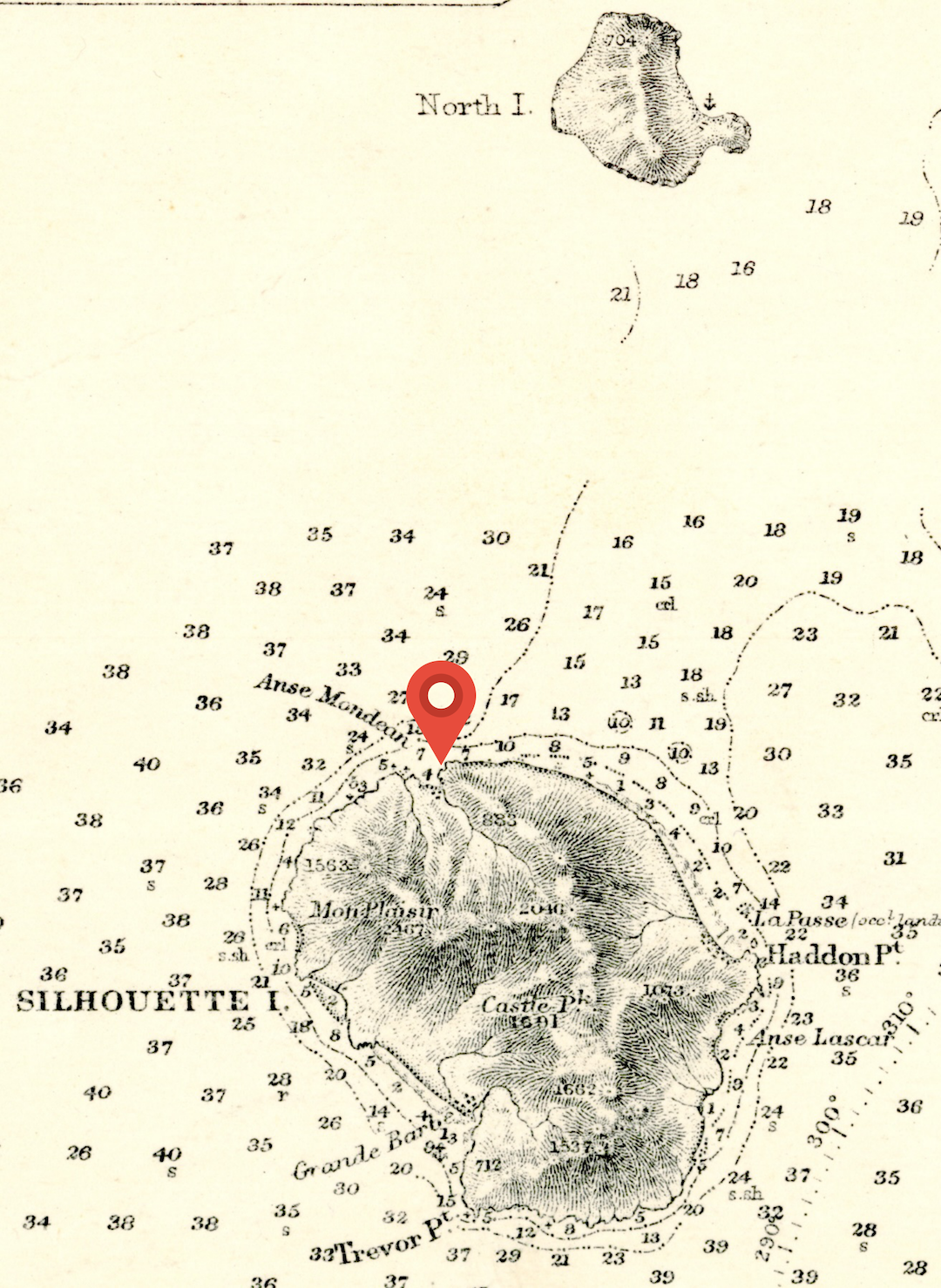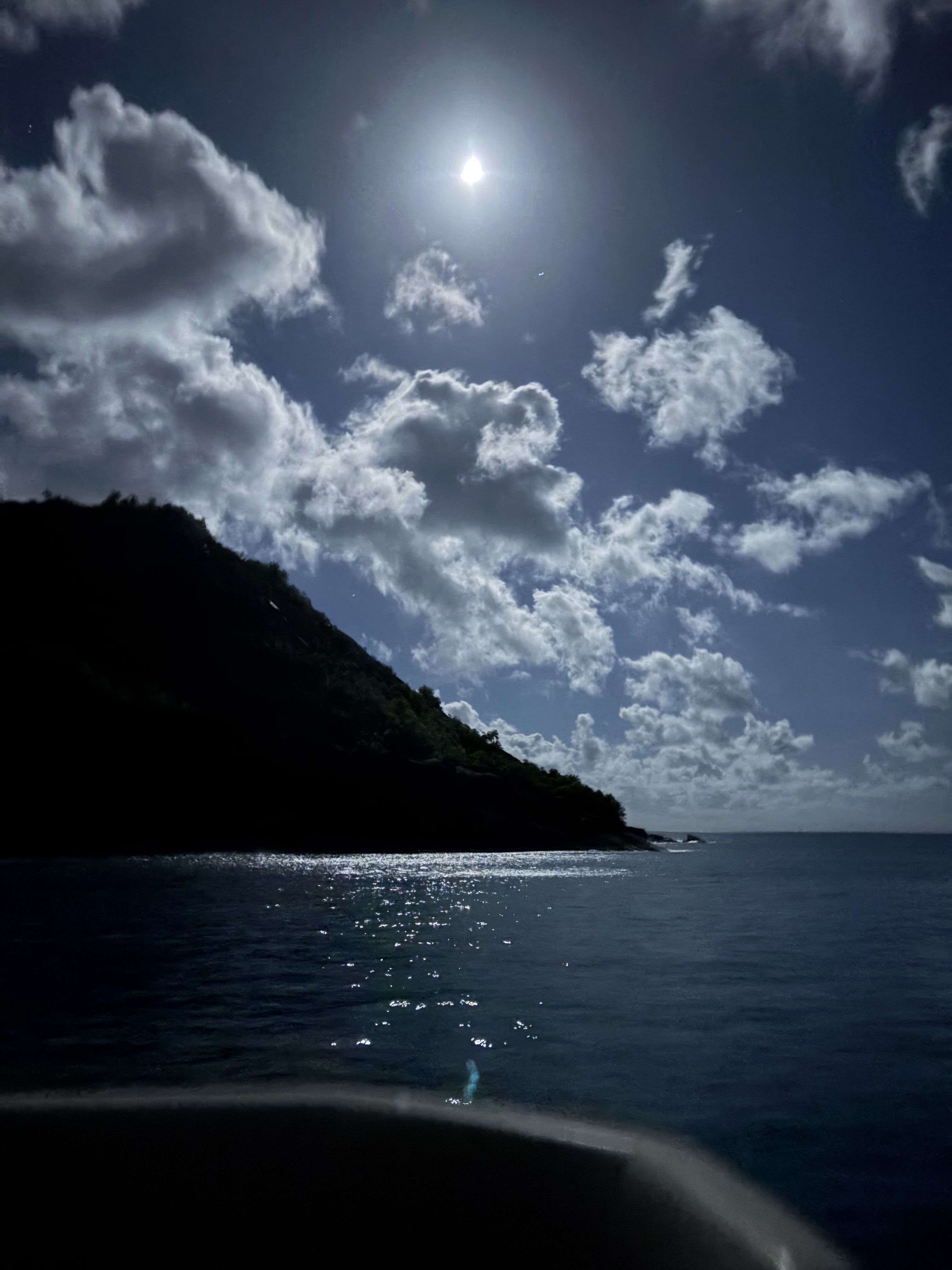Silhouette Island
We motored north through Cerf Passage until we cleared the wind shadow of Sainte Anne Island, then turned northwest in the general direction of Silhouette Island and put up sails in a light breeze. The wind speed and direction varied somewhat, so we weren’t traveling in a straight line, but it felt good to be underway, and even better to have the motor off. The conditions were perfect for getting a little familiarity with the boat.
As we neared the island, we dropped sail and fired up the iron gennies. A squall that looked harmless enough from a distance passed over our general vicinity and completely obscured the island behind a curtain of heavy rain. There were a few nervous moments where we slowed the boat down and switched to digital navigation until the rain had passed and we could see the island again.

Anse Mondean was a tiny nick in the northern shoreline of the island just deep enough to offer modest protection from passing swells, and on this particular day it was on the leeward side of the island. We tried multiple times to set the anchor in 4-5 meters of water, but the plow anchor kept dragging on the sandy bottom. We finally got it set well enough to keep the boat from moving in the wind, but not enough to withstand putting the engines in reverse (the ideal way to set an anchor), so it was decided that a Danforth anchor would be set from the stern to keep the boat from swinging too much.
The Danforth anchor was in a forward locker. It sat atop a big pile of heavy rode, but when we removed everything from the locker, we discovered that the rode wasn’t attached to the anchor’s chain. The rode had eyes on each end that prevented us from using a bowline knot to attach it. A shackle would have been the ideal solution but we couldn’t find a spare one on board, so we had to scavenge one from the lines used to hoist the dinghy out of the water.
Once the rode had been attached to the anchor, everything was loaded into the dinghy, which Irina and Robbi then motored a few dozen yards from the stern of Takamaka and dropped the second anchor. They came back aboard and we all had dinner together. Just before nightfall, a local fishing boat showed up and dropped anchor about 100 yards further out from our location.
The boat still seemed to be moving around a lot, though not necessarily dragging anchor. For the sake of everyone sleeping better, we agreed on a watch schedule through the night where each of us would be up on deck for 90 minutes to keep an eye on things. My time slot was from 3:30 a.m. to 5, and Colleen would follow, taking us to sunrise. I got up when the alarm on my phone went of at 3:20 a.m. and relieved Alisa. The fishing boat appeared much closer than when I’d gone to bed the night before. The breeze seemed to be constantly shifting, making the boat dance and swing between its two anchor lines. There were a few times where I was on the brink of rousing the skipper thinking that anchor was dragging, but then the boat’s drift toward the rocks would halt and it would slowly return to a more comfortable location. When the moon set at about 4:45 a.m., it became even harder to tell the distance between Takamaka and the shore and the fishing boat. I woke Colleen up a little past 5 and we sat together until the dawn light crept in from the east at about 5:20 and it was easier to judge the distances between us and the various hazards.
A conversation that we’d had with one of Rodney’s friends when we’d first landed on Beau Vallon beach indicated that there was a population on Silhouette Island, and we saw a ferry going to and from the island. But if there was a population, there was no trace of it visible from Anse Mondean. Other than two concrete columns set atop one of the large pieces of granite that served as the only indication of a human presence on the island, it was all dense jungle growing in and around large faces of granite.

Moon setting over Silhouette Island at 3:30 a.m. - Photo courtesy of Alisa